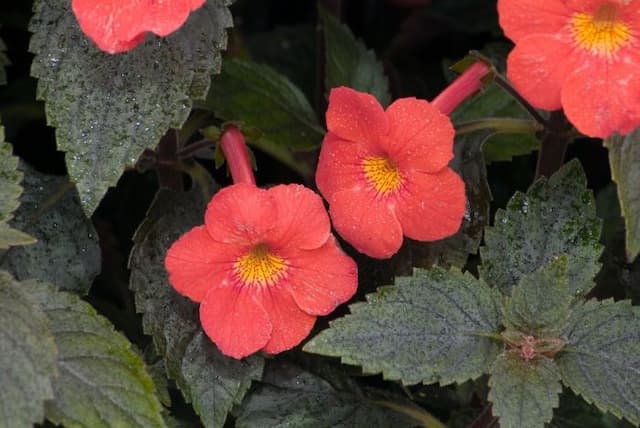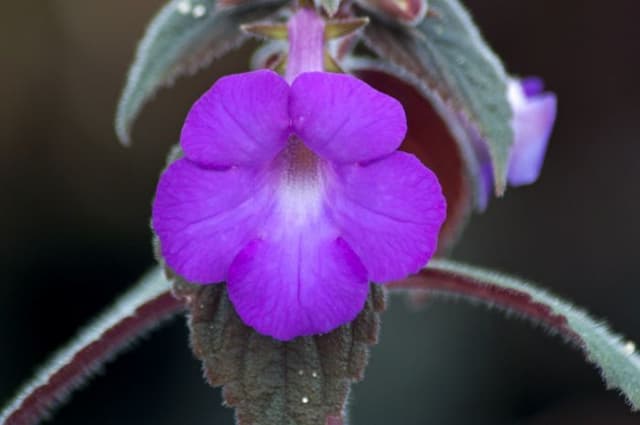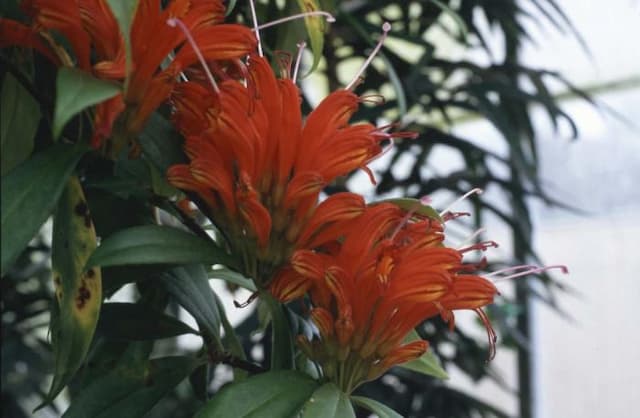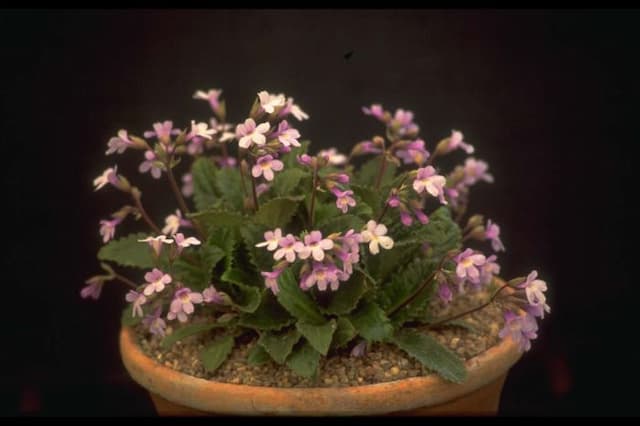Cape Primrose Streptocarpus 'Cynthia'

ABOUT
Streptocarpus 'Cynthia' is a flowering houseplant known for its beautiful and vibrant flowers. These blossoms are notable for their velvety texture and their striking coloration, typically showcasing shades of purple with contrasting yellow and white throats. The petals often have a trumpet-like shape, fanned out in a display that adds a splash of color to any indoor space. The leaves of 'Cynthia' are lush and elongate, with a deep green color and a slightly wrinkled or textured surface. They grow in a basal rosette formation, which means they form a cluster at the base of the plant. The foliage provides a dense backdrop that makes the vivid flowers stand out even more. The overall appearance of Streptocarpus 'Cynthia' is one of lush foliage paired with a continual show of ornamental blooms that can last throughout the growing season, giving it a charming and long-lasting presence in a home or office.
About this plant
 Names
NamesFamily
Gesneriaceae
Synonyms
Cape Primrose, African Violet, Twisted Fruit
Common names
Streptocarpus 'Cynthia'.
 Toxicity
ToxicityTo humans
Cape Primrose (Streptocarpus 'Cynthia') is generally not known to be toxic to humans. There are no well-documented cases of poisoning by ingestion of this plant. However, as with any non-food plant, it is advisable to avoid ingestion and to keep it out of reach of small children who may be inclined to eat plant parts, as individual allergic reactions or gastrointestinal discomfort may occur.
To pets
Cape Primrose (Streptocarpus 'Cynthia') is also generally considered non-toxic to pets such as dogs and cats. It is not listed on common toxic plant databases, and there is limited information on adverse reactions in pets. However, ingestion of non-food plants can sometimes lead to mild gastrointestinal upset in animals, so it is wise to prevent pets from ingesting this plant. If a pet does consume Cape Primrose and displays signs of distress, consulting a veterinarian is recommended.
 Characteristics
CharacteristicsLife cycle
Perennials
Foliage type
Evergreen
Color of leaves
Green
Flower color
Purple
Height
6 inches (15 cm)
Spread
12 inches (30 cm)
Plant type
Herb
Hardiness zones
10
Native area
Africa
Benefits
 General Benefits
General Benefits- Easy to Care For: Streptocarpus, also known as Cape Primrose, requires minimal maintenance, making it ideal for busy plant owners or beginners.
- Long Blooming Period: Cape Primrose flowers for a considerable length of time, often from spring to autumn, providing a long period of visual enjoyment.
- Compact Size: Its small stature allows it to fit into limited spaces, making it suitable for small apartments or offices.
- Aesthetic Appeal: With its beautiful and varied flowers, it adds a splash of color and enhances the aesthetic of any room.
- Variety: Streptocarpus 'Cynthia' offers a diversity of flower colors and patterns, which can cater to different tastes and decors.
- Propagation: It can easily be propagated from leaf cuttings, allowing gardeners to create more plants without additional cost.
 Medical Properties
Medical PropertiesThis plant is not used for medical purposes.
 Air-purifying Qualities
Air-purifying QualitiesThis plant is not specifically known for air purifying qualities.
 Other Uses
Other Uses- Artistic Inspiration: Artists and photographers may find the vibrant colors and velvety texture of the Cape Primrose petals inspiring for their work, perhaps leading to botanical illustrations or macro photography projects.
- Educational Tool: Botany instructors can use Cape Primrose as a live example to teach students about plant biology, hybridization, and the diverse adaptations of flowering plants.
- Humidity Indicator: Because Cape Primrose thrives in high humidity, wilting or dry leaves could indicate a need to adjust ambient moisture levels in a room, benefitting other nearby humidity-loving plants.
- Gift Plant: Their attractive blooms and long flowering period make them ideal as thoughtful gifts for plant enthusiasts or for occasions such as Mother's Day or birthdays.
- Container Gardening: The compact size and non-invasive nature of the Cape Primrose make it suitable for small spaces and container gardens.
- Feng Shui: Some practitioners of Feng Shui may use Cape Primrose to add a soft, yin energy to a space, creating balance and a peaceful atmosphere.
- Plant Competitions: Horticulture enthusiasts can cultivate Cape Primrose for local plant shows or contests, valuing their unique colors and forms.
- Craft Projects: The flowers of the Cape Primrose can be pressed and used for various craft projects like making homemade cards, bookmarks, or botanical art.
- Photoperiod Research: The flowering cycle of Cape Primrose, influenced by light exposure, can be used in educational settings or experiments related to plant photoperiodism studies.
- Sensory Gardens: The soft texture and bright flowers can provide a sensory experience in gardens designed for those with special sensory needs, promoting touch and sight stimulation.
Interesting Facts
 Feng Shui
Feng ShuiThe African Violet is not specifically used in Feng Shui practice.
 Zodiac Sign Compitability
Zodiac Sign CompitabilityThe African Violet is not used in astrology practice.
 Plant Symbolism
Plant Symbolism- Endurance: Streptocarpus, also known as Cape Primrose, often symbolizes endurance due to its ability to thrive with minimal care and in conditions where other plants might struggle.
- Persistence: The plant's long flowering season, which can last up to a good part of the year, suggests persistence and the ability to sustain effort over time.
- Variety: With its wide range of colors and patterns, Cape Primrose can also represent the beauty of diversity and a variety of choices in life.
- Adaptability: Cape Primrose adjusts well to indoor environments, symbolizing adaptability and the ability to prosper in various conditions.
 Water
WaterFor the Cape primrose, water thoroughly when the top inch of soil feels dry to the touch, typically once a week, but this can vary depending on the humidity and temperature of your home. Use room temperature water and gently pour it directly onto the soil until water runs out of the drainage holes, which might equate to about 8-16 ounces for small pots every watering session. During the winter months, reduce watering to prevent waterlogging as plant growth slows down. Always avoid letting the Cape primrose sit in standing water as it can lead to root rot.
 Light
LightCape primroses thrive in bright, indirect light, away from direct sunlight which can scorch their leaves. A north-facing or east-facing window that provides several hours of diffuse light is ideal, ensuring the plant gets enough light without the harmful effects of intense midday sun. If natural light is limited, consider using a grow light to supplement.
 Temperature
TemperatureThe Cape primrose prefers a temperate climate with temperatures ranging between 60 to 75 degrees Fahrenheit for optimal growth. It can survive minimum temperatures of 50 degrees Fahrenheit, but should not be subjected to temperatures below this as it could cause stress and damage. Avoid placing the plant in drafts or near heating and air conditioning vents.
 Pruning
PruningPrune the Cape primrose to remove any yellowed or dead leaves and spent flowers to encourage new growth and maintain a tidy appearance. Pruning is best done in the spring or early summer when the plant is actively growing. Cut back the foliage by up to one-third if the plant becomes leggy or overgrown, which typically should be done annually.
 Cleaning
CleaningAs needed
 Soil
SoilCape Primrose prefers a well-draining soil mix, such as a combination of peat moss, perlite, and vermiculite, ensuring high humidity retention. An ideal pH range for this mix should be mildly acidic to neutral, roughly between 6.0 to 7.0.
 Repotting
RepottingCape Primroses should be repotted every 12-18 months to avoid becoming root-bound and to replenish their soil with fresh, nutrient-rich mix.
 Humidity & Misting
Humidity & MistingCape Primrose thrives in moderate to high humidity levels, ideally between 50-60% for optimal growth.
 Suitable locations
Suitable locationsIndoor
Provide bright, indirect light and keep soil moist for Cape Primrose.
Outdoor
Shelter Cape Primrose from direct sun, ensure warm, shaded spot.
Hardiness zone
10-11 USDA
 Life cycle
Life cycleStreptocarpus 'Cynthia', commonly known as Cape primrose, starts its life cycle as a seed which germinates in moist, well-draining soil with indirect light. The seedling stage sees the emergence of cotyledons followed by true leaves, at which point the plant slowly matures into a rosette form. In its vegetative stage, the rosette of leaves expands, and the plant develops a robust root system. This is followed by the flowering stage, where Cape primrose produces vibrant tubular flowers that are key to its ornamental appeal. After pollination, which may be facilitated by insects, the plant sets seed within a twisted, spirally fruit, completing the reproductive cycle. Cape primrose is a perennial, so it may enter a period of dormancy, especially in cooler months, before resuming growth and repeating the cycle.
 Propogation
PropogationPropogation time
Spring-Summer
Cape Primrose 'Cynthia' can be propagated effectively through leaf cuttings, which is the most popular method for this plant. The best time for propagation is during the spring or early summer when the plant's growth is most vigorous. To propagate, a healthy, full-grown leaf is selected and cut across the main vein at an angle. The leaf is then inserted into a moistened, well-draining potting mix, ensuring that the cut surface is in contact with the soil. Enclosing the pot in a plastic bag can create a mini-greenhouse effect, maintaining high humidity around the leaf cutting. Roots usually develop within a few weeks, after which new shoots will emerge, and the new plants can be potted separately once they are big enough to handle.









